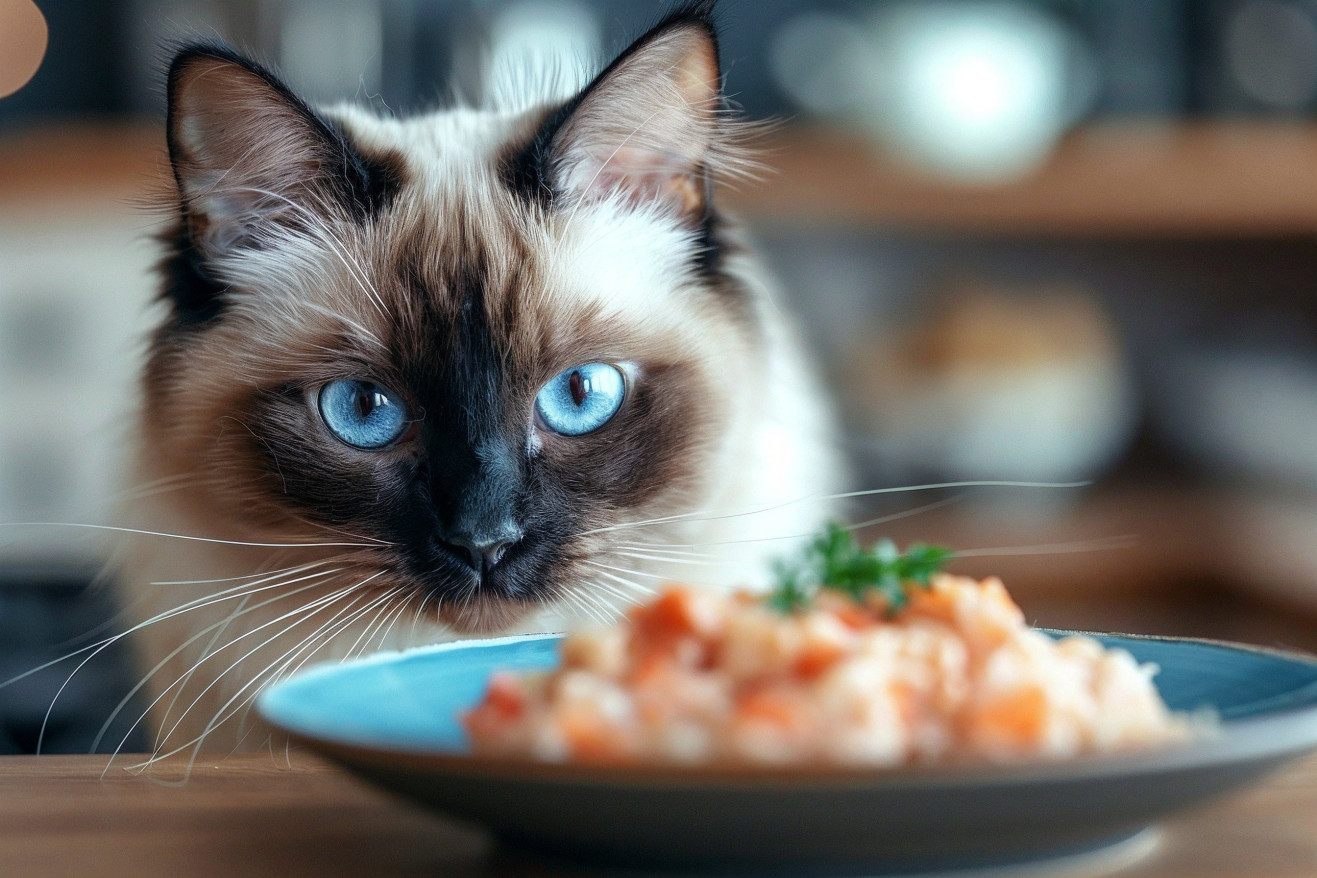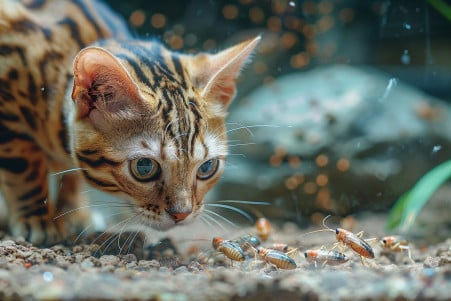Can Cats Eat Crab? Safely Adding Seafood to Your Cat’s Diet
12 March 2024 • Updated 11 March 2024

Crab is a tasty treat for humans, but can you share it with your cat? Cooked, shell-free, and unseasoned crab meat is safe for cats to eat in moderation. However, crab is high in sodium, so it should be fed to cats in small amounts. Raw crab, shells, imitation crab, and canned crab should be avoided. Always introduce new foods to your cat slowly and ask your vet for personalized advice.
In this article, we’ll discuss cat nutrition and the place of crab meat in a cat’s diet, and we’ll turn to veterinary nutrition studies to learn about the nutritional requirements of cats and the role of seafood, including crab, in their diet.
We’ll also look at research that investigates the potential benefits and drawbacks of feeding crab to cats and we’ll discuss how to introduce new foods to make sure your cat’s diet is well-rounded.
This article will help you understand how to safely prepare seafood for cats and explain why it’s important to feed cats a balanced diet that includes a variety of foods in moderation.
Can cats eat crab?
Cat Nutrition and the Role of Seafood in Their Diet
Cats are obligate carnivores, which means they need animal-based proteins to get essential amino acids and other nutrients that are necessary for their health and well-being.
VCA Animal Hospitals explains that cats have evolved to depend on the specific forms of nutrients that are only found in animal tissue, including taurine, certain essential fatty acids, minerals, and vitamins. The types of protein that cats need are most readily available in animal tissue, so it’s important for cats to have a well-rounded diet that includes the right amount of animal protein.
Seafood, including crab meat, is a good source of animal protein and can be a healthy addition to a cat’s diet if it’s prepared and served correctly. PetMD notes that animal proteins, including those found in seafood, contain the eleven essential amino acids that cats can’t make on their own.
However, there are potential downsides to feeding cats seafood, including the risk of food allergies and the fact that seafood is high in sodium, which can be dangerous for cats if they consume too much.
The Purina Institute suggests that cat owners use moderation and monitor their pet’s reaction when they’re introducing new foods, including crab, into their diet. By introducing a new food slowly, it’s possible to monitor for negative reactions and make sure that the treat doesn’t throw off the nutritional balance of the cat’s diet.
Since every cat is different and has different nutritional needs, it’s always a good idea to talk to a vet before making any dietary changes.
Nutritional Value of Crab
Crab is a tasty and nutritious type of seafood that can provide some nutritional benefits to your cat. According to WebMD, crab is a good source of protein, vitamins (including vitamin B12 and folate), and minerals (including iron, niacin, selenium, and zinc), all of which are important for cats and help with everything from supporting the immune system to promoting energy.
The protein in crab is particularly important for cats, who are obligate carnivores, and the omega-3 fatty acids in crab can help promote heart and brain health.
That said, it’s important to feed your cat crab in moderation due to its high sodium content, which can be harmful in large amounts. WebMD notes that a 3-ounce serving of crab contains 376 milligrams of sodium, which is a good reminder of the importance of portion control. In addition, because cats can be sensitive to changes in their diet, it’s best to introduce crab as an occasional treat.
In addition to portion control, it’s important to prepare crab in a way that makes it safe and easy for your cat to eat.
Cuteness recommends cooking the crab without any spices and making sure it’s free of any bones to ensure that it’s safe for your cat to eat. By keeping these things in mind, cat owners can make sure that they’re feeding their pets crab in a way that maximizes its benefits and minimizes any potential downsides.
Omega-3 Fatty Acids and Your Cat’s Seafood Diet
Omega-3 fatty acids, especially EPA (eicosapentaenoic acid) and DHA (docosahexaenoic acid) found in seafood like crab, are essential for cats. These fatty acids help with brain function, reduce inflammation, and support heart health.
A publication in PMC even suggests that EPA and DHA have therapeutic effects that can help with the treatment of conditions like osteoarthritis and skin diseases in cats. However, because the body’s ability to convert alpha-linolenic acid (ALA) to DHA and EPA is limited, especially in cats, dietary sources are needed to realize these benefits.
While omega-3 supplements can be safe and helpful when used under the guidance of a veterinarian, DVM360 warns that they can also have negative effects. For example, over-supplementation can result in toxicity, which underscores the importance of moderation. In addition, the environmental impact of eating seafood is a concern. A study in Communications Earth & Environment shows that the growing demand for seafood raises questions about sustainability and the need for responsible sourcing.
While feeding your cat seafood like crab to provide omega-3 fatty acids can be helpful, it’s important to be aware of potential allergies, individual health concerns, and the larger environmental issues. Taking a well-rounded approach ensures that we’re taking care of our cats’ health while also being aware of the impact our choices have on the environment.
Seafood Allergies in Cats
While seafood is often a healthy option, it can also cause allergic reactions in cats. VCA Animal Hospitals explains that if your cat is allergic to seafood, you will notice symptoms like itching, skin inflammation, and gastrointestinal issues such as vomiting or diarrhea. Cat owners should watch for signs of discomfort, excessive licking, and changes in bowel movements that could be a sign of an allergy to seafood, including crab.
Cats with allergies will need other sources of protein. KOHA Pet explains that novel protein cat foods offer a variety of options including rabbit, duck, and venison that are less likely to cause allergies because they are new to the cat’s immune system.
Wag Walking says that the most effective way to diagnose and treat food allergies is to use an elimination diet trial. This involves working with a vet to remove common allergens and introduce novel proteins to determine the cause of your cat’s allergies and then adjust their diet to ensure they are allergy-free and healthy and happy.
Since it’s important to make sure your cat is getting a well-rounded diet, it’s important to make sure you’re providing safe and enjoyable options for cats with seafood allergies.
How to Add Crab to Your Cat’s Diet
If you’ve decided to add crab to your cat’s diet, there are a few things you should keep in mind. First, make sure to choose plain, cooked crab meat—don’t give your cat raw, seasoned, or canned crab, which can be full of harmful additives and sodium.
PetMD recommends that you take one to two weeks to transition your cat to a new food to avoid stomach issues. Start by mixing a small amount of crab with your cat’s regular food, and then slowly increase the amount of crab.
For example, start with 75% regular food and 25% crab and work your way up to 100% crab over the course of a few days. A more detailed plan from Royal Canin suggests that you increase the amount of crab in your cat’s food over the course of seven days to minimize stress and stomach issues.
Make sure to watch your cat for any signs of intolerance or allergies, including vomiting, diarrhea, and a loss of appetite. It’s also important to make sure that you keep your cat’s feeding schedule and environment as consistent as possible to minimize stress during this time.
While crab can be a healthy addition to your cat’s diet, it’s important to make sure that you’re adding it in a way that complements your cat’s overall diet. This means that high-quality, complete foods should still make up the bulk of your cat’s diet, with crab being added in occasionally to make your cat’s meals more interesting without throwing off their nutritional balance.
Conclusion: Can Cats Eat Crab?
To sum up, cats can eat crab as long as it’s prepared and served properly and in moderation. The high protein content in crab makes it a good fit for cats, who are obligate carnivores and need meat to get essential nutrients.
However, the high sodium content and potential allergens in seafood mean that it’s important to be careful. To make sure that crab is safe for cats, it should be prepared correctly—cooked without any added seasonings, served in moderation, and free of bones.
It’s important to talk to a vet before adding any new food, including crab, to a cat’s diet to make sure that it meets their individual health and dietary needs. As a responsible pet owner, the goal is to make sure that you’re giving your cat a diet that meets their needs while also making sure that they’re happy, and that can include giving them occasional treats like crab.
By carefully considering evidence-based guidelines and your cat’s individual needs and preferences, you can make choices that will help support their health and well-being and keep them happy and healthy. With this in mind, you can feel confident that you’re making the right choices when it comes to giving your cat treats like crab that will help ensure that they’re not just happy but also thriving in your care.


